Abstract
In this research, we identified whether the norms of university ethics were observed in the teaching activities carried out online in the context of the Covid-19 pandemic. For university education, the transfer of courses and seminars to a virtual environment is more than a passing challenge. Its demanding and unpredictable nature was intended to be a good opportunity to test and validate our resilience skills in conjunction with our ability to successfully adapt to new contexts. The research was conducted in February and March 2022, through the socio-pedagogical survey, using a research tool the questionnaire, applied via google forms to a sample of 359 students studying at the University of Pitesti and residing in the South Muntenia region, Romania. The results of the research want to highlight the following aspects: whether students perceived as effective participation in online teaching activities, whether they knew their rights and respected their responsibilities in the conduct of online education, their representation in the development of the on-site learning system.
Keywords: Pandemic, students, teaching activities, university ethics
Introduction
The default font for this template is Times New Roman. University ethics is determined by the “…set of intra-institutional structures and tools to ensure the effective management of immoral behavior that poses a risk to the organization” (Mureșan, 2013, p. 47). According to researchers, there are similarities between all Romanian universities regarding the development of concrete activities for preventing immoral behavior, but also certain specific aspects are determined by the type of university education (Aslam et al., 2018). The crisis caused by the COVID-19 pandemic severely affected the personal experiences of both students and teachers, as well as professional ones. Therefore, knowing and respecting these premises will be relatively easy for us to adapt the teaching activity to new educational contexts, including online teaching-learning-assessment, and the respective socio-pedagogical survey will prove its usefulness. To have a positive impact on the teaching-learning-assessment, based on the quality of learning and the norms of academic ethics, using the facilities offered by information technology and communication via the Internet, the previously used teaching strategies had to be rethought. In the researchers’ vision,as in any organization and in universities, we can talk about a general and collective level of morality, located beyond the morality of each member of that institution (Socaciu et al., 2018). Universities are spaces designed to facilitate the transmission and progress of knowledge through teaching and research activities, and for this to occur in optimal conditions, it is necessary for students to know their rights and respect their responsibilities and which are provided in the Code of University Ethics as in any type of organization.
Problem Statement
Universities in Romania (and around the world) have adopted Codes of Ethics, which are committed to respect a series of general ethical values and principles, from which specific moral rules are derived, with the role of guiding ethical decisions and providing a model of behavior moral. This study aims to help increase the resilience of higher education systems - systems that are more flexible, fully dedicated to ALL students, systems that educate through various ways/methods and technologies and that are better equipped to cope possible crises. Universities should maintain, as they return to traditional face-to-face teaching, numerous practices they have resorted to during the pandemic and online teaching.
Research Questions
At the beginning of the COVID-19 pandemic, academics and students had to learn very quickly the new ways to conduct teaching activities (courses and seminars) in an online environment and to create resources for their development in optimal conditions. The question is whether universities have adapted, respected the rights and responsibilities of students and provided systematic and effective support for teaching-learning-assessment using digital tools. How do students rate this? Does the online teaching activity enjoy a level of trust and satisfaction among the students? Should this change remain a part of the culture of higher education? In this regard, universities should continue to encourage and prepare teachers to be creative and flexible in the way they design their teaching activities and interact with students.
Purpose of the Study
The current study determines whether the teachers at the University of Pitești have succeeded, in the context of the Covid-19 pandemic, through their additional efforts to develop close ties of solidarity with students, even in the conditions of online education, considering the needs of everyone, both students and teachers, to deal with social isolation. Certain strategies for conducting teaching activities should be encouraged even after the resumption of teaching activities in physical presence. I mention that this research had as sample 359 students, future teachers in pre-university education.
Therefore, I consider that their general perception regarding the teaching activities carried out online and the observance of the university ethics are relevant for keeping some solutions for organizing the teaching activities, such as group discussions, surveys, or other digital interaction tools. They can also be used in the case of conducting educational activities in physical presence. In this sense, the education conducted in a hybrid format can facilitate the use of both traditional tools for organizing teaching and digital activities in classrooms and seminars. These can be combined into solutions that capture students' attention and motivate them to learn. I also aimed to determine whether the students consider that their rights have been respected and know and respect their academic responsibilities in the conditions of conducting online activities, the results of the socio-pedagogical survey being relevant in the context of rethinking the future way of conducting online activities line, on site or hybrid.
Research Methods
We chose to use the socio-pedagogical survey as a research method, using the questionnaire as a research tool. Because in a pandemic context its application could not be done otherwise, I chose to develop the questionnaire in google forms and distribute it to students through groups made them on whatsapp. The answers were confidential and showed an interest in the topic of the questions. In developing the questions, we sought to obtain general answers about moral values that are valid cultural standards for all members of the academic community and guide our moral behavior. The moral rules regarding the development of teaching-learning-assessment activities with the rights and responsibilities of students are derived from the Code of University Ethics and require students and teachers to behave in this way. These have been brought to the attention of the entire academic community repeatedly.
Most of the students participating in this survey (92.2%) are female, perhaps because they will soon be teachers in pre-university education, a profession that many girls want to embrace (Figure 1).
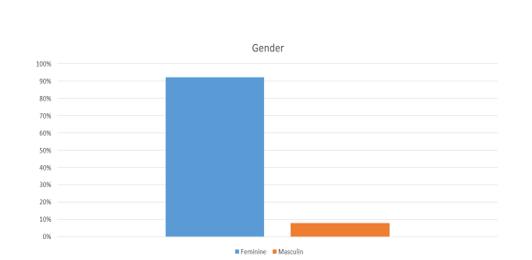
Academic integrity is built on ethical behavior, generating a culture based on academic honesty and intellectual rigor, in which the educational act tends to excellence and is supported by a fair and objective assessment, both teachers and students must contribute to prevention, identifying and reporting the actions that endanger this desideratum, so that the university can intervene and sanction the reprehensible facts. For these reasons, I considered it relevant to determine whether the students had consulted the Code of Ethics and University Deontology of the University of Pitești and know its provisions. 84.6% of the students who considered it appropriate to answer the questions in the questionnaire answered positively (Figure 2).
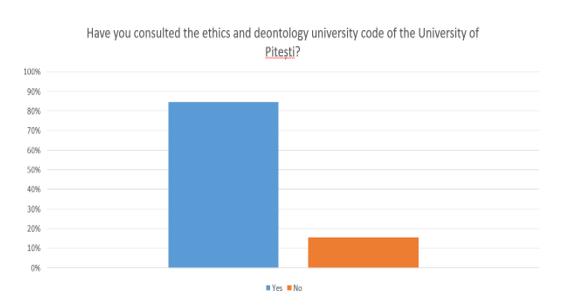
Distance learning in emergencies (or distance learning in emergencies illustrates the situation where courses and seminars are offered through distance learning due to a crisis situation, sometimes without being planned or organized for distance education It refers to a sudden (and often hurried) transition from learning in a classroom to distance education and/or virtual classrooms and seminars. inclusive, and distance learning, in recognition of the fact that online learning has been planned and organized, while distance learning is mainly about the use of technology to perform tasks designed for classroom teaching (United Nations International Children’s Emergency Fund [UNICEF], 2021).
Therefore, it was necessary to develop methodologies regarding the development of the entire teaching process in a pandemic context in accordance with the observance of legal norms and pedagogical principles by the university management. These were brought to the attention of both teachers and students. 96.6% of the students who chose to answer the questions of this questionnaire stated that they were informed about the form of teaching activities during this period, according to the approved methodologies (Figure 3).
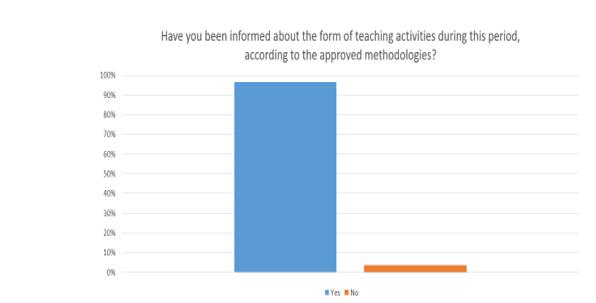
A particularly important aspect is related to the frequency with which they participate in the teaching activities carried out in the online environment. The pandemic has profoundly affected education and exacerbated existing social inequities, as evidenced by student activities. Planning activities in such an environment is not an easy task. The loss of learning periods can have lasting effects on students in the coming years and following solid decision-making principles is essential and is the premise for increasing the resilience of the university education system. 58.9% of the surveyed students permanently participated in online teaching activities, 34.6% participated frequently, which leads us to conclude that it is much more convenient for them to connect online to the activities that occur. Thus, we can say that distance learning tools help equalize access to learning, eliminating some physical restrictions that make it difficult for students to participate in face-to-face teaching. It would be advisable for some of them to be preserved and become essential in university teaching (Figure 4).
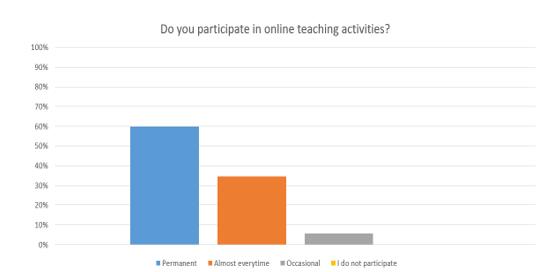
In crises, such as the Covid-19 pandemic, which limited the usual ways of intra-institutional communication, but also those with the external environment, it was imperative to find viable and effective communication alternatives to the classic ones, which imposed “changes in management in this regard”(Băloiu, 1995, p. 131) 97.8% of students sometimes attended courses and seminars from anywhere, excluding a formal framework. This may be possible because the online education system allows new ways of interaction, communication The whole academic community (teachers and students) has been put in a position to cope with profound changes, to approach new methods of relationships and communication, to work, materialized in emotional tensions that have intensified due to uncertainty (Figure 5).
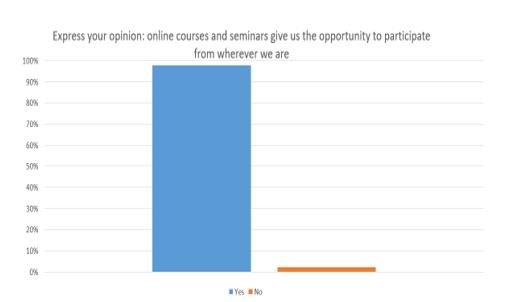
Most of the students (83.8%) said that they were participating in online courses or seminars at the same time as in other activities, we could understand that they were involved in an activity at work, in a household activity or leisure. In the context of the pandemic, as expected, the facilitation of the transmission of information on compliance with the rules, values and procedures contained in the University Codes of Ethics has changed. The methods used facilitated the transmission of information regarding the rights and obligations of students, the rules of conduct of academic and non-academic staff, facilitating compliance with ethical and moral standards accepted in the university environment. By using technology, the number of interactions has increased, but to the detriment of their depth (Figure 6).
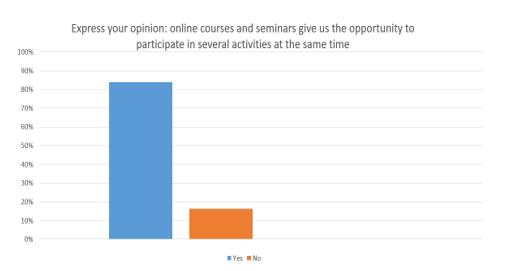
The most important purpose of university training processes, whether they occur through direct interaction, in hybrid form or online, is to develop professional and transversal skills specific to each academic specialization. The conduct of the assessment process in an online environment received some special connotations and it was necessary to focus the assessment process on verifying the extent to which students have assimilated the various elements specific to professional skills. Academic evaluation involves, First, a moment of reflection on the significance we give to the student regarding the evaluation process. Numerous advantages and opportunities created by the presence of the environment and electronic tools can also be realized and capitalized. 90.5% of the students appreciated that in the online environment they were evaluated objectively. In the educational context, feedback should refer to the information that teachers receive from students about the quality of performance and the results obtained by them, by reference to performance criteria (Figure 7).
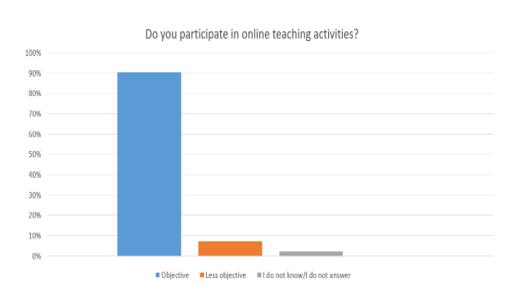
A percentage of 66.8 of students agree to conduct online teaching activities, only 22.6% would like to physically participate in these activities, and 10.6% are undecided. The results obtained derive from the fact that online activities can be accessed anytime and anywhere, students can choose according to the areas of interest in which activities to participate and can access them individually. The time allotted for the assessments may not be determined as in a classroom, as the schedule is much more flexible. Students can go through the proposed material independently, being able to speed up the learning process or slow down. Also, the interaction in an online community allows them not to be present at the same place or time, and the evaluation can be similar (Figure 8).
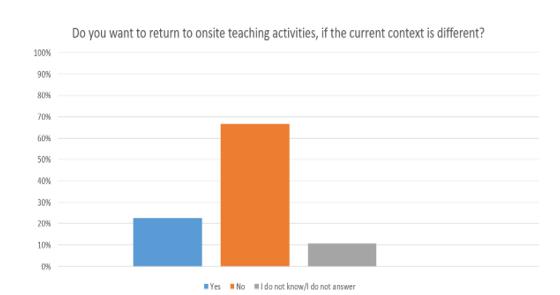
From another perspective, students have the opportunity to present more information with perhaps less emotional involvement. 46.8% consider that they made the same effort to learn and participate in teaching activities as when the on-site learning process occurred. 28.7% considered that they put more effort, and 22.8% of the students claimed that they made less intellectual effort. Careful planning of online learning involves not only identifying the content of the course but also carefully designing the types of interaction to support the learning process. However, almost half of them they appreciate that they put in the same effort, and between those who said they put in more effort and those who put in less, the results are almost similar. It is important to realize that the use of technology can be attractive, but the content exposed in the online environment may be more difficult to assimilate in conditions where their understanding is not facilitated by the teacher (Figure 9).
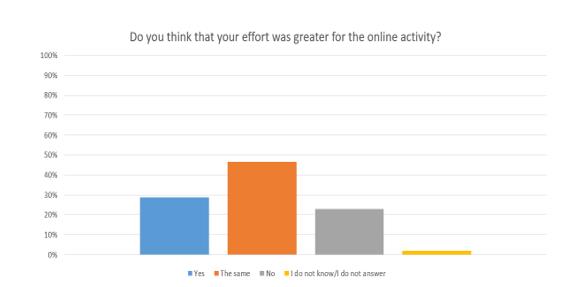
Within the pandemic context and based on the University Code of Ethics, order to address the issue of unethical behavior, it was necessary to adapt the promotion methods previously used. It was facilitated the transmission of information on the responsibilities and rights of students, the rules of professional conduct of the academic staff facilitating compliance with ethical and moral standards accepted in the university environment. Thus, 97.5% of the students appreciated that they respected the responsibilities incumbent to them, provided in the decisions of the university management and the methodologies adopted for the organization and implementation of the educational process during this period (Figure 10).
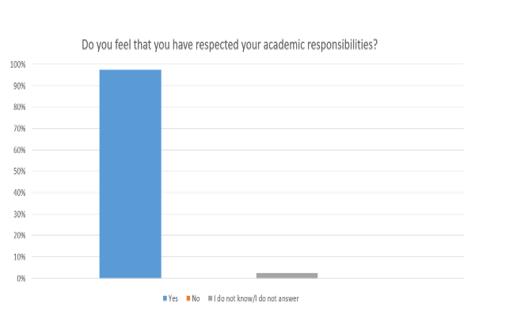
The COVID-19 pandemic has probably led to the world's worst disruption to education and training systems since then, threatening an entire generation of students with the loss of a volume of study information and decades of progress; whereas this loss of knowledge is likely to lower the income level of this generation in the future and have a negative impact on increasing labor productivity and competitiveness. This generation is facing an entry into the labor market under the strong influence of the economic crisis caused by the COVID-19 pandemic. During this period, students had the same rights they enjoyed, but there were probably other students in other academic contexts who faced the absence of digital equipment, inadequate digital skills or learning, often without the support of a teacher, colleagues. or those at home and sometimes in an unstable family environment. However, in terms of academic rights, 93.3% of students stated that they were respected (Figure 11).
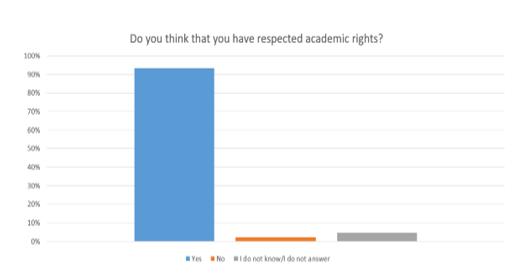
Almost all of the students (98.9%) consider that they have perfected certain technological skills during this period. This pandemic crisis has accelerated the transition to digital learning and stimulated innovation in education. Investments in universities that have recently strengthened online education and online learning solutions; these issues play an important role in promoting innovation in the education sector (Figure 12).
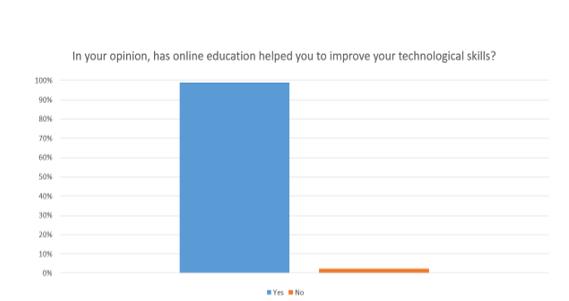
Internet networks, intra-net platforms, pre-existing databases (the existence of the online community) made it easier for both students and teachers: disseminating information; access to content; clarification of some aspects regarding the didactic activities; identifying practical solutions to problems; transmission of documents prepared for evaluation. 72.1% of the surveyed students considered that the online teaching activities were more efficient, while 13.1% denied their efficiency, and 14.8% did not know how to appreciate or refused to give an answer with this aspect. For those who did not appreciate the effectiveness of online activities, I believe that the uncertainty caused by this crisis has sometimes affected the ability of students to process certain information obtained in teaching activities, as some information may be more abstract or complicated. in this case, it was more difficult to assign real meaning to the information received (Figure 13).
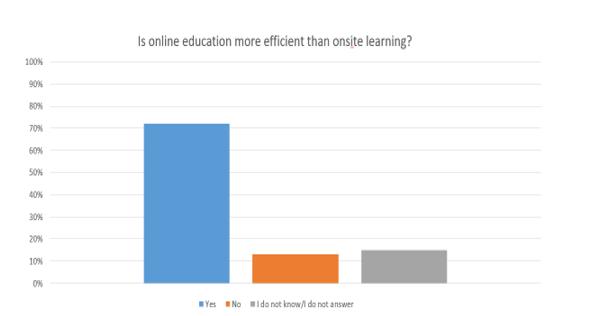
Digitization is found in many social fields. However, we cannot deny the inefficiency of communication in formal education, generated by the form of online teaching. The transmission of information, the need for students to interact with both teachers and colleagues and the availability and ease of students to intersect their personal and educational environment has suffered in the context of the Covid-19 pandemic felt the stress of using the Internet and digital channels for a long time. Because 81.1% of students believe that the university is a social institution. The teaching activities have shifted their development through the alternative channels of the online environment. Recent experience leads us to understand that this method for interacting online has, however, limited valence and is used exclusively does not fulfill all the functions that face-to-face socialization fulfills (Figure 14).
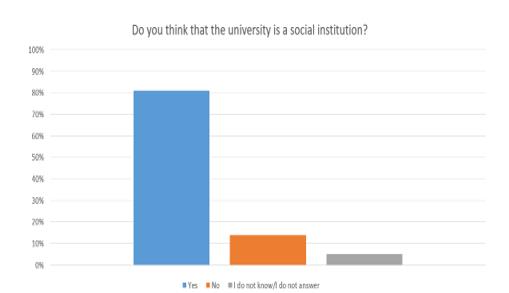
Returning to onsite teaching activities represents a second significant change in the education system. In the construction of the individual’s own vision of the world, the fundamental role is played by education, which the individual has during the first stages of his existence, but also later in various directions, especially thanks to “the social environment in which he lives and works” (Mihăilescu, 2019, p. 16). Only 43.5% of students wanted to see their peers and teachers face to face as soon as possible, if the context allows, while 34.3% denied this, considering it easier to learn and interact with them through devices. 22.3% refused to answer or are undecided. It is possible that the teaching activities carried out online distorted the image of the university in the minds of the students and what it should have meant. But, I believe, the students who responded positively are those who in this pandemic period that lasted more than two years, failed at all to physically interact with their teachers and colleagues, they being practically those who signed up. in the first year of college in this context. The physical interaction is impossible at all. “Socialization” develops students’ healthy abilities and skills with which they can successfully meet the challenges of life in which they will soon be fully responsible, to develop their ability to interact with others in ways that will produce results. positive - sharing, cooperation, help(Figure 15).
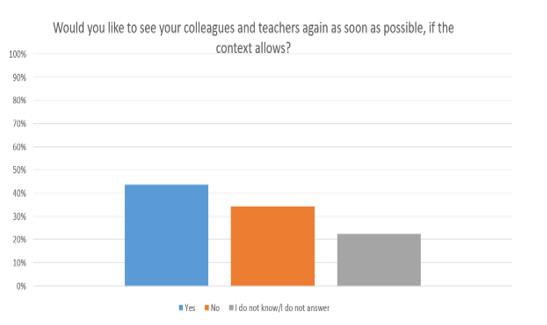
Findings
There is no perfect or absolute set of answers and there may not be an ideal return to on-site teaching activities. Rather, each university will have to establish its own optimal and minimum conditions for organizing activities. However, the teaching-learning activity is an empathic act, no matter how efficient the technology is, it cannot access a side that is the basis of healthy human development, the emotional one and the feelings, the soul feelings cannot be transmitted, beliefs cannot be created. However, regarding the results obtained, we can realize that elements are positively appreciated by the students and regarding the manner of conducting the teaching-learning-evaluation activities online. However, in the approach of hybrid education, the traditional methods for teaching/learning / assessment can be combined with digital tools and resources. This new approach involves using technology not only as a tool for content delivery, but also as a resource to support and facilitate the development of new skills and abilities in students. “Another important component of hybrid education is equitable access to quality educational resources for all students. The success of certain teaching activities, such as teaching content, depends almost exclusively on the prior preparation of these activities by teachers” (American Chamber of Commerce in Romania [ACCR], 2021, p. 10).Thus, the teacher must guide the student's learning experience, which would allow individualizing the educational process and their educational path, allowing them to develop the critical and analytical skills necessary for lifelong learning.
The academic community has, in its mission, a responsibility toward the development of the society in which it finds itself. This involves conducting activities in accordance with the values and principles of the community and the Code of Ethics. However, a problem of university ethics, conjunctural, may be the one through which the laws and legal recommendations had to be fully respected in case of extreme situations, in the context of the COVID-19 pandemic.
The crisis we have been in for two years has led us to participate in radical changes that involve real revolutions, shocks in the structure or functioning of universities, which have led us to rethink the use of technology and the functioning of academia. It involves the restructuring of academic organization, structure and culture.
With the premise of such an objective, the management of educational institutions had to make decisions and implement different ways of educational interaction between teachers and students. In some cases, there are clear decisions on how to interact with the educational community (for example, the legal regulations of the university to use only certain educational platforms to be used in the educational activity); In other cases, however, teachers and students have accessed various forms of education, almost conventional. This way of educational interaction, without teacher training in adapting teaching strategies can have negative long-term effects, but in the short term and in a crisis, the right solutions have ensured continuity and stability in the educational process.
If we consider that the main beneficiary of university education is the student, then society is directly interested in their preparation, and higher education must be student-centered, it was essential to analyze issues related to university ethics and respect for students' rights and responsibilities. in the context of conducting this type of education, online. Therefore, the elaboration of all decisions and methodologies was guided by the observance of these important principles.
Conclusions
The moral ideal of autonomy presupposes that we can adhere only to those rules that result from a process of rational and impartial deliberation that is not our immediate. Influences do not raise special difficulties, as long as they are transformed only into considerations that we will consider, equally and objectively, in the process of rational deliberation. When analyzing an ethical issue, we need a compass to guide us in developing an answer to what we need or are allowed to do. Often, the situations we are in are complicated and we do not have time to weigh all the details. That's why we use rules that almost work most of the time.
In the pandemic context, academic ethics has experienced intense challenges, and due to the complexity determined by the new reality, ethical dilemmas have a new dimension generated by the difficulty of delimiting in practice between unethical behavior and professional error. There is a need in academic communities to debate multiple aspects of these new dilemmas, to share practical approaches, to generate action models. Romanian universities have gone through and continue to go through many reforms, on many levels: curricular, administrative, economic, etc. In this context, the need for the ethical component in most decisions made daily at their level is a major challenge for higher education. We are facing a change in the educational paradigm.
Thus, to improve the performance within the instructive-educational process, there is a need to adopt a new model of hybrid education (blended learning), at the level of the entire public and private accredited system of university education in Romania, which could answer the systemic problems of education and be able to meet the new learning needs of students. Such a learning model would address the immediate needs for developing modern educational content or the democratization of education by increasing the access of all students to quality education.
Education can benefit from the opening of classrooms, real-life experiences and projects, and new learning tools, materials, and open educational resources. Students can benefit from online collaboration. Access to and use of digital technologies can help reduce the learning gap between students from high- and low socio-economic backgrounds. Personalized teaching can increase motivation by focusing on the individual student. However, the progress in the integration of technology in education remains limited by the existence of material and financial resources, but also by teacher training, while according to the results obtained in this socio-pedagogical survey we noticed enough availability from students.
Avoiding disruptions in learning, teaching and communication discontinuities is certainly a priority for all education systems. And it’s not just a continuum of learning - this is a multifaceted phenomenon, fueled by various sources, which always happens everywhere, not just in the classroom – it’s not just educational content, but a pedagogical one. This would mean a deliberate organization of teachers' efforts to maintain a consistent, meaningful and meaningful connection between teachers and students.
References
American Chamber of Commerce in Romania. (2021). Education adopting the hybrid education model in the context of the Strategy on the digitization of education in Romania 2021-2027, 10. https://www.amcham.ro/download?file=committeePaper/u6iflXg.pdf&filename=Document%20de%20pozitie%20privind%20invatamantul%20hibrid.pdf
Aslam, C., Moraru, C. F., & Paraschiv, R. (2018). Ethics and academic integrity course. National University of Arts Publishing House.
Băloiu, L. M. (1995). Innovation Management. Eficient Publishing House.
Mihăilescu, N. (2019). Ethics management in the school institution. http://www.cnaa.md/files/theses/2020/55660/natalia_mihailescu_abstract.pdf
Mureșan, V. (2013). Why do we need an ethical infrastructure? in vol. A philosopher lost in the agora. All Publishing House.
Socaciu, E., Vică, C., Mihailov, E., Gibea, T., Mureșan, V., & Constantinescu, M. (2018). Ethics and academic integrity. University of Bucharest Publishing House.
United Nations International Children’s Emergency Fund. (2021, June, 8). Creating resilient education systems in the context of the COVID-19 pandemic: Considerations for decision-makers at the national, local and school levels. https://www.dspsv.ro/uploads/PromovareaSanatatii/Scoli%20deschise/Considerente%20pentru%20factorii%20de%20decizie%20de%20la%20nivel%20local%20si%20national.pdf
Copyright information

This work is licensed under a Creative Commons Attribution-NonCommercial-NoDerivatives 4.0 International License.
About this article
Publication Date
10 April 2023
Article Doi
eBook ISBN
978-1-80296-961-0
Publisher
European Publisher
Volume
5
Print ISBN (optional)
-
Edition Number
1st Edition
Pages
1-1463
Subjects
Education sciences, teacher education, curriculum development, educational policies and management
Cite this article as:
Pescaru, M. (2023). Considerations for Universitary Ethics in the Context of the Covid Pandemic 19. In E. Soare, & C. Langa (Eds.), Education Facing Contemporary World Issues - EDU WORLD 2022, vol 5. European Proceedings of Educational Sciences (pp. 693-708). European Publisher. https://doi.org/10.15405/epes.23045.70

